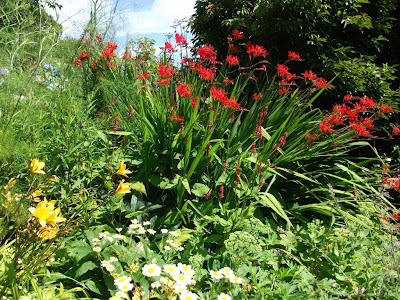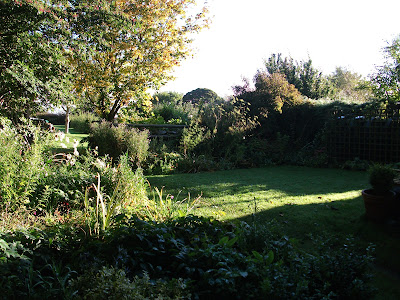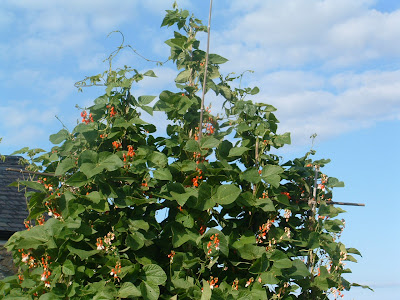The side garden is the only part of the garden which is the scale and size of the gardens I used to have before we came here. This was where I started although it was really born in 2009 after it had spent quite a time as a builders' yard. This picture shows it at the end of January 2011. There is very little going on in January and the path through to the workshop and the field is worn and muddy every winter. We have got as far as talking to a builder/contractor friend about a path. Every winter I hate slipping and sliding and curse the mud and the way it makes everything look tatty. Every summer I forget how bad it was.
The same view at the end of January 2012 with the same muddy path in deep shade! I planted some evergreen plants down this end of the side bed to try to give some structure: an Euonymus fortuneii which should ultimately get quite large, three sarcococca hookeriana humilis (sweet box) which has sweet smelling winter flowers and seven hellebores of various kinds. Last year I left the fennel in the back bed to stand through the winter and I have done the same this year.
End of February 2011 and the hellebores and the snowdrops are in flower. The hellebores keep going for weeks and weeks. I wish I had been more disciplined about keeping a garden notebook when I first put these in so I would have some idea what they are although I suppose hellebores throw up so many lovely forms it almost doesn't matter.
I seem not to have taken the distance view at the February 2012 but these detail pictures show that the snowdrops are filling out and the hellebores hanging their graceful heads. I think that I should establish some more hellebores in the back bed so that all the flowering is not concentrated at one end of the side bed. There are a couple in the back bed already but there is scope for some more on the right as you go through into the field.
End of March 2011 and the hellebores are still going strong, the daffodils are flowering and the pulmonaria Diana Clare is out. I love the strong blue of this and I have split it up and put some more further along the bed.
This is 2012 with lots of small red tulips, Praestans Fusilier, flowering with the pulmonaria. I liked the red and blue so much that I have just put 40 more tulips into the side garden. The ones I have put in today are Scarlet Baby, part of the Peter Nyssen order (this is their image too).
Scarlet baby
End of April 2011
End of May 2011 and the garden is mainly foliage apart from the hardy geraniums and the odd allium.
End of May 2012 and everything is far lusher and more vivid, principally because of all the alliums I put in. I wonder if I can rely on them to do their stuff again this year? I haven't ordered any more so I really hope so. I know they can naturalise and even take over from talking to friends who have a superabundance but so far they have not started to do that for me, in fact I seem to lose some every year.
End of June 2011 and the main colour is the day lillies.
End of June 2012. This shows the oriental poppies. They are the bane of my life: beautiful for a fleeting week or so and then leave devastation behind them. They also want to take over the world and this year I have thrown away half a dozen plants, guiltily. This photo also shows that it is really worth having foxgloves. I have a few seedlings that Karen gave me in the greenhouse but I didn't sow any more seed this year - mistake!
End of July 2011. I suspect this was the highlight of the 2011 garden. The eremurus were stunning and the crocosmia Lucifer is always fantastic.
July 2012. Oddly having the gazebo up because we were having a party makes the garden look better, perhaps because it distracts the eye from the fact that there is not a whole lot going on! The crocosmia is good though as is the geranium Anne Folkard which flowers and flowers and spreads as it goes.
End of August 2011. This demonstrates what always happens here - everything stops apart from the brave rudbeckia in this photo which was going last year. I lost that last winter. How can you lose a rudbeckia? I thought they were tough as old boots. I think this is an example of something which happens to me quite a lot. The plants that are really happy here such as the fennel and the michelmas daisies muscle out those which would happily grow but have yet to make a big clump. I need to police new plants much more rigorously until they have really got their roots down and do a bit more judicious pulling up of the bullies.
End of August 2012. The foliage was better this year (all that rain?) and the shasta daisies are earning their keep. They have only just finished flowering which is pretty fantastic. I like them even though they are far from unusual. This is making me feel I should do some serious editing of the side garden. There are too many aquilegia which I like but which have hardly featured in the record of what works in here. The corner where the crocosmia and persicaria sit side by side needs rejigging, with the persicaria moved into the shadier area along with some of the geranium. I wonder if I should just bite the bullet and dig up either all the poppies or all the michelmas daisies? Giving room to two such thugs means that other things are being crowded out.
End of October 2011 - practically no colour! Must have missed taking an end of September set.
And again no end of September for 2012 ( that seems to be telling me that there is nothing worth taking photos of!). October shows that same tiredness and flop this year too. I know this is the case but looking at the whole year in this way really makes the point that the side garden is a spring and early summer place. I might sacrifice some of the aquilegia, geranium or the poppies and michelmas daisies for a couple of places in each border which are really motoring in September and October.
Time to go away and do some serious thinking. I hate bringing things in here which die and it happens sadly frequently. I need tough plants but also things which will provide really singing colour in late summer and early autumn. Things which put down deep roots often thrive and things which do not need a deep, moist soil. I have previously tried and failed with dahlias which have gone to live much more happily in the cutting garden. Any suggestions gratefully received.




































.JPG)




 In the cutting garden the echinacea has established much better this year. I love it and will look for some other varieties to have another row. All the cosmos is self sown bar a couple of plants which came up from my greenhouse sowing. I think the seed was not fresh enough but if they self seed as well again next year they will become something which the garden is never without. I loved the white cosmos at Bodnant. I will try growing quite a lot from seed next year as they are an ideal plant to put in front of chopped down oriental poppies.
In the cutting garden the echinacea has established much better this year. I love it and will look for some other varieties to have another row. All the cosmos is self sown bar a couple of plants which came up from my greenhouse sowing. I think the seed was not fresh enough but if they self seed as well again next year they will become something which the garden is never without. I loved the white cosmos at Bodnant. I will try growing quite a lot from seed next year as they are an ideal plant to put in front of chopped down oriental poppies. The fennel is lovely again. I will sow some more from the kitchen garden one when it sets seed. Three plants from last year's sowing are in the side garden and are beginning to bulk up. They are a lovely plant. Perhaps I should look for a bronze one too.
The fennel is lovely again. I will sow some more from the kitchen garden one when it sets seed. Three plants from last year's sowing are in the side garden and are beginning to bulk up. They are a lovely plant. Perhaps I should look for a bronze one too.
 They all have lovely long stems and are ideal as cut flowers - just what the cutting garden is supposed to be doing!
They all have lovely long stems and are ideal as cut flowers - just what the cutting garden is supposed to be doing! A rather bleached out picture of some of the new bed in the side garden. The euphorbias really earn their keep as do the erysimum bowles mauve. The clary which I grew from seed has also been a good and tough addition. The white foxgloves have been a lovely flower but really suffered from the wind tunnel effect at the side of the house.
A rather bleached out picture of some of the new bed in the side garden. The euphorbias really earn their keep as do the erysimum bowles mauve. The clary which I grew from seed has also been a good and tough addition. The white foxgloves have been a lovely flower but really suffered from the wind tunnel effect at the side of the house.
